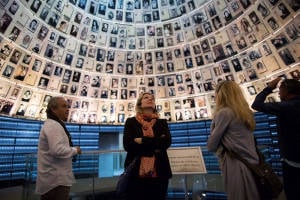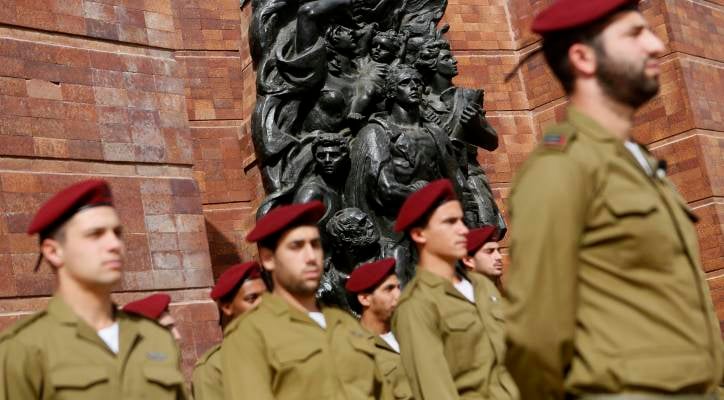Holocaust Remembrance Day (Yom Hashoah in Hebrew) is a national day of commemoration in Israel, on which the six million Jews murdered in the Holocaust are memorialized. This year, due to coronavirus, mass events will be virtual.
By United with Israel Staff
Yom Hashoah is a solemn day, beginning at sunset each year on the 26th of the Hebrew month of Nisan and ending the following evening, according to the traditional Jewish custom. Places of entertainment are closed and memorial ceremonies are held throughout the country.
The central ceremonies, in the evening and the following morning, are held at Yad Vashem and are broadcast on television. In previous years, marking the start of the day – in the presence of the President of the State of Israel and the Prime Minister, dignitaries, survivors, children of survivors and their families, gathered together with the general public to take part in the memorial ceremony at Yad Vashem in which six torches, representing the six million murdered Jews, are lit.
The following morning, the ceremony at Yad Vashem begins with the sounding of a siren for two minutes throughout the entire country. For the duration of the siren, work is halted, people walking in the streets stop, cars pull off to the side of the road and everybody stands at attention in silent reverence to the victims of the Holocaust.
Afterward, the focus of the ceremony at Yad Vashem is the laying of wreaths at the foot of the six torches, by dignitaries and the representatives of survivor groups and institutions. Other sites of remembrance in Israel, such as the Ghetto Fighters’ Kibbutz and Kibbutz Yad Mordechai, also host memorial ceremonies, as do schools, military bases, municipalities and places of work.
This year, due to COVID-19, these events will be limited.
Survivors Build a New Life
On May 9, 1945, when the defeated Germans finally capitulated to the Allied Forces, great joy spread throughout the world. Yet one nation did not take part in the general euphoria – the Jews of Europe. For them, victory had come too late.

Visitors at the Yad Vashem Holocaust Memorial Museum in Jerusalem. (Yonatan Sindel/Flash90)
At the war’s end, it became apparent that some six million Jews had been murdered – about one-third of world Jewry. Those who had survived were scattered throughout Europe: tens of thousands of survivors of the camps and death marches, liberated by the Allied armies on German soil and in other countries, were in a severely deteriorated physical condition and in a state of emotional shock. Others emerged for the first time from various places of hiding and shed the false identities they had assumed, or surfaced from partisan units with whom they had cast their lot and in whose ranks they had fought for the liberation of Europe.
In the wake of international agreements signed at the end of the war, some 200,000 additional Jews began to make their way back West from the Soviet Union, where they had fled and managed to survive the war years.
With the advent of liberation, piercing questions arose in the minds of the survivors: How would they be able to go back to living a normal life, to build homes and families? And having survived, what obligation did they bear towards those who had not? Was it their duty to preserve and commemorate their legacy? Were the survivors to avenge them, as they demanded before their death?
The overwhelming majority of survivors took no revenge on the Germans, but set out on a path of rehabilitation, rebuilding and creativity, while commemorating the world that was no more.
By: Prof. Dina Porat – Chief Historian, Yad Vashem
Watch: The Will to Live (1947) – The Spielberg Jewish Film Archive
Jewish refugees after World War II receive aid in immigrating to pre-State Israel and the US.
Watch: The Death March to Volary (Yad Vashem)
On January 20, 1945, approximately 1000 female Jewish prisoners were forced on a death march from Schlesiersee (today Sława) camp in Upper Silesia, Poland. On the way, the prisoners passed through other camps, and more women were added to the march. 106 days later, on May 5, 1945, after covering a distance of over 800 km (500 miles), the march ended in the town of Volary in Czechoslovakia. Of the 1300 women who marched to Volary, only around 350 survived.
‘Unto Every Person There is a Name’
Six million Jews, among them 1.5 million children, were murdered in the Shoah while the world remained silent. The worldwide Holocaust memorial project, “Unto Every Person There is a Name,” is a unique project designed to perpetuate their memory as individuals and restore their identity and dignity, through the public recitation of their names on Yom Hashoah. By personalizing the individual tragedies of the Jewish victims of Nazi Germany and its collaborators, this project counters persistent efforts by enemies of the State of Israel and the Jewish people to deny the reality of the Holocaust and cast it as history’s seminal hoax.
“Unto Every Person There is a Name” is conducted around the world in hundreds of Jewish communities through the efforts of four major Jewish organizations: B’nai B’rith International, Nativ, the World Jewish Congress and the World Zionist Organization. The project is coordinated by Yad Vashem, the Holocaust Martyrs’ and Heroes’ Remembrance Authority, in consultation with the Israel Ministry of Foreign Affairs and enjoys the official auspices of the President of the State of Israel Shimon Peres. In Israel, “Unto Every Person There is a Name” has become an integral part of the official Yom Hashoah commemoration ceremonies, with the central events held at the Knesset and at Yad Vashem with the participation of elected officials, as well as events throughout the country.
Click here for lists of names of Holocaust victims.
Memories@Home
Over the past few years, many young adults have been participating in a program called Memories@Home (Zikaron BaSalon in Hebrew), whereby a host invites a Holocaust survivor to his or her private home for discussion with a small audience. As the website explains, such a setting provides an alternative way for young Israelis, including many who feel increasingly disconnected from the official Holocaust Remembrance Day events, to commemorate the Holocaust “in an innovative, meaningful and respectful way.”
The programs are organized by groups of friends, often university students. Anyone can host. Guests are welcome to express themselves artistically, such as by reading a poem, playing a song, telling a story or showing a short film.
These events “offer the possibility to listen, think, talk, feel and connect with the memories of survivors as well as to ponder the challenges,” facing the world today, organizers say.
In some cases, the speaker is a 2nd or 3rd generation survivor speaking about the trauma that affects children and grandchildren of those who experienced the Nazi atrocities.
Of course, due to the coronavirus pandemic, this year the events will be hosted online.
The Jewish Agency for Israel will host two special virtual Yom HaShoah events, bringing Jews around the world together to hear from Holocaust survivor Leah Hason. Her heartbreaking story will be presented on the organization’s Facebook page and will be broadcast in eight languages as part of The Jewish Agency’s Shlichut Institute program, together with the “Zikaron BaSalon” (Memories in the Living Room) Project.
(With files from the Israel Government Press Office)
